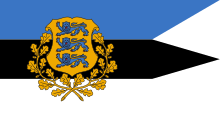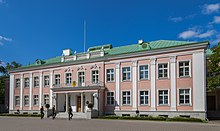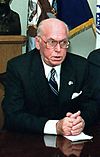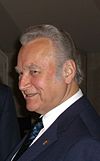ผู้ใช้:Koroyawin/ทดลองเขียน4
หน้านี้เป็นหน้าทดลองเขียนส่วนบุคคลของโคโรยาวิน กรุณางดการแก้ไขหน้านี้ บทความทดลองเขียนในปัจจุบันคือ: ประธานาธิบดีเอสโตเนีย
| ประธานาธิบดีแห่งสาธารณรัฐเอสโตเนีย | |
|---|---|
 ธงประจำตำแหน่ง | |
| การเรียกขาน | ท่านประธานาธิบดี (ไม่เป็นทางการ) ฯพณฯ (ทางการทูต) |
| จวน | ทำเนียบประธานาธิบดี |
| ผู้แต่งตั้ง | รีกิโกกุ / Electoral College (สลับกันไปจนกว่าผู้สมัครจะมีคะแนนเสียงข้างมากตามที่กำหนด) |
| วาระ | 5 ปี ต่ออายุได้ติดต่อกัน |
| ตราสารจัดตั้ง | รัฐธรรมนูญแห่งเอสโตเนีย |
| ผู้ประเดิมตำแหน่ง | Konstantin Päts |
| สถาปนา | 24 เมษายน 1938 |
| ยกเลิก | 1940–1991 |
| รอง | โฆษกประจำรีกิโกกุ |
| เงินตอบแทน | €6,661.77 ต่อเดือน[1] |
| เว็บไซต์ | president |

ประธานาธิบดีแห่งสาธารณรัฐเอสโตเนีย (เอสโตเนีย: Eesti Vabariigi President) เป็นประมุขแห่งรัฐของประเทศเอสโตเนีย[2] ประธานาธิบดีคนปัจจุบันคือ อาลาร์ การิส ซึ่งได้รับเลือกจากรัฐสภาเมื่อวันที่ 31 สิงหาคม ค.ศ. 2021 แทนที่ Kersti Kaljulaid[3]
เอสโตเนียเป็นหนึ่งในสาธารณรัฐไม่กี่แห่งที่มีประธานาธิบดีเป็นบุคคลสำคัญในพิธีการโดยไม่มีอำนาจบริหารแม้แต่น้อย ประธานาธิบดีมีหน้าที่ต้องระงับการเป็นสมาชิกพรรคการเมืองใด ๆ ตลอดระยะเวลาที่ดำรงตำแหน่ง เมื่อเข้ารับตำแหน่ง อำนาจและหน้าที่ของประธานาธิบดีในตำแหน่งที่ได้รับการเลือกตั้งหรือแต่งตั้งอื่น ๆ ทั้งหมดจะสิ้นสุดลงโดยอัตโนมัติ ในทางทฤษฎีมาตรการเหล่านี้จะช่วยให้ประธานาธิบดีทำงานในลักษณะที่เป็นอิสระและเป็นกลางมากขึ้น ประธานาธิบดีดำรงตำแหน่งเป็นเวลาห้าปี อาจได้รับเลือกกี่ครั้งก็ได้แต่ไม่เกินสองครั้งติดต่อกัน
ในเอสโตเนีย ประธานาธิบดีได้รับเลือกโดยรีกิโกกุ;[4] ผู้สมัครจะต้องชนะสองในสามของเสียงข้างมากจึงจะได้รับการเลือกตั้ง หากไม่มีผู้สมัครคนใดได้รับเสียงสนับสนุนสองในสามในรีกิโกกุ หลังจากการลงคะแนนเสียงสามรอบ จะมีการเรียกประชุมหน่วยเลือกตั้งพิเศษซึ่งประกอบด้วยสมาชิกทั้งหมดของรีกิโกกุ และผู้แทนที่ได้รับการเลือกตั้งจากทุกเทศบาล (อย่างน้อยหนึ่งคนต่อหนึ่งเทศบาล แต่ไม่เกิน 10 คน ขึ้นอยู่กับจำนวนประชาชนที่มีสิทธิออกเสียงที่อาศัยอยู่ในเขตเทศบาล) องค์กรนี้เลือกระหว่างผู้สมัครสองคนที่มีคะแนนเสียงมากที่สุด
ในขณะที่กระบวนการเลือกตั้งนี้ถูกวิพากษ์วิจารณ์ แนวคิดเรื่องการเลือกตั้งโดยตรงไม่ได้รับการสนับสนุนเพียงพอในรัฐสภา โดยมีเพียงพรรค Estonian Center และพรรค Conservative People's Party เท่านั้นที่ออกมาปกป้อง[5][4][6][7]
ประวัติ[แก้]
ผู้เขียนรัฐธรรมนูญเอสโตเนียฉบับแรก มีความทรงจำเกี่ยวกับการใช้อำนาจในทางที่ผิดของจักรพรรดิรัสเซีย พวกเขาจึงพยายามทุกวิถีทางที่จะหลีกเลี่ยงการรวมอำนาจมากเกินไปไว้ในมือคนคนเดียว ในที่สุดสิ่งนี้นำไปสู่การสร้างระบบรัฐสภาแบบพิเศษ อำนาจของรัฐสภา (รีกิโกกุ) แทบไม่มีขีดจำกัด จนถึงปี ค.ศ. 1934 ประมุขแห่งรัฐที่ได้รับการแต่งตั้งคือผู้อาวุโสแห่งรัฐ (riigivanem) ซึ่งดำรงตำแหน่งประธานคณะรัฐมนตรีโดยนิตินัยด้วย ซึ่งรู้จักกันอย่างเป็นทางการว่า "รัฐบาล" อย่างไรก็ตาม เขาไม่สามารถมีบทบาทที่เป็นกลางได้ในกรณีที่เกิดความขัดแย้งระหว่างรัฐสภากับรัฐบาล ผู้อาวุโสของรัฐและรัฐบาลขึ้นอยู่กับรัฐสภาอย่างสมบูรณ์และสามารถถูกไล่ออกได้ทุกเมื่อ หน้าที่ที่มักจะตกเป็นของประธานาธิบดีในระบบรัฐสภานั้นถูกแบ่งระหว่างโฆษกประจำรีกิโกกุ ผู้อาวุโสแห่งรัฐ และรัฐบาล
รัฐธรรมนูญของเอสโตเนียได้รับการแก้ไขในปี ค.ศ. 1933 จัดตั้งระบบประธานาธิบดีที่เข้มแข็ง ประมุขแห่งรัฐตามรัฐธรรมนูญฉบับใหม่เรียกอีกอย่างว่าผู้อาวุโสแห่งรัฐ แต่คราวนี้ตกเป็นของผู้มีอำนาจบริหาร อย่างไรก็ตาม รัฐธรรมนูญนี้ไม่เคยมีผลบังคับใช้เนื่องจากการรัฐประหารตัวเองของ Konstantin Päts ในปี 1934 ต่อมาในปี 1938 ได้มีการประกาศใช้รัฐธรรมนูญฉบับอื่น และตำแหน่งประมุขแห่งรัฐได้เปลี่ยนเป็น "ประธานาธิบดีแห่งสาธารณรัฐ" เขาได้รับอำนาจบริหารที่กว้างมาก แม้ว่าเขาจะค่อนข้างมีอำนาจน้อยกว่าผู้อาวุโสแห่งรัฐตามรัฐธรรมนูญปี 1933 ก็ตาม Konstantin Päts กลายเป็นบุคคลแรกที่ได้รับตำแหน่งนี้ วาระของเขาจะคงอยู่เป็นเวลาหกปี

ภายในไม่กี่วันหลังจากการยึดครองเอสโตเนียของกองทัพโซเวียตในเดือนมิถุนายน ค.ศ. 1940 Päts ถูกบังคับให้แต่งตั้งรัฐบาลหุ่นเชิดที่ปกครองโดยคอมมิวนิสต์ นำโดยJohannes Vares หลังจากการมาถึงของผู้ประท้วงพร้อมด้วยทหารกองทัพแดงพร้อมรถหุ้มเกราะไปยังทำเนียบประธานาธิบดี รัฐบาล Vares ได้รับเลือกโดย Andrei Zhdanov เจ้าหน้าที่โซเวียต หลังจากการเลือกตั้งหลอกลวงในเดือนกรกฎาคม ประธานาธิบดี Päts ถูกไล่ออกจากตำแหน่ง ต่อมาในเดือนกรกฎาคม Päts พร้อมด้วยลูกชาย ลูกสะใภ้ และหลานชายอีกสองคน ถูกเนรเทศไปยัง Ufa ในประเทศรัสเซีย
ตามรัฐธรรมนูญ ค.ศ. 1938 ในกรณีที่ประธานาธิบดีไร้ความสามารถหรือไม่สามารถปฏิบัติหน้าที่ได้ นายกรัฐมนตรีจะรับหน้าที่แทนภายใต้หัวข้อ "นายกรัฐมนตรีในหน้าที่ของประธานาธิบดี" ตามบทบัญญัตินี้ Vares เข้ารับตำแหน่งแทนประธานาธิบดีเป็นเวลาสองสามสัปดาห์ระหว่างการยึดครองของสหภาพโซเวียต จนกระทั่งเอสโตเนียถูกผนวกและรวมเข้ากับสหภาพโซเวียตอย่างเป็นทางการในเดือนสิงหาคม ค.ศ. 1940 อย่างไรก็ตาม ในช่วงเวลาแห่งสงครามหรือการไร้ความสามารถซึ่งกินเวลานานกว่าหกเดือน รัฐธรรมนูญกำหนดให้มีการเลือกตั้งรักษาการประธานาธิบดีโดยสภาการเลือกตั้ง ในการประชุมลับเมื่อวันที่ 20 เมษายน ค.ศ. 1944 สภาการเลือกตั้งตัดสินว่าการแต่งตั้ง Vares เป็นนายกรัฐมนตรีในปี ค.ศ. 1940 ไม่ชอบด้วยกฎหมายตามรัฐธรรมนูญ ค.ศ. 1938 สภาจึงได้เลือก Jüri Uluots เป็นรักษาการประธานาธิบดีเมื่อวันที่ 21 เมษายน และได้แต่งตั้ง Otto Tief เป็นนายกรัฐมนตรี ต่อมา Tief ถูกจับกุมโดยกองกำลังโซเวียตที่ยึดครองอีกครั้งในเดือนกันยายน ค.ศ. 1944
ในเดือนกันยายน ค.ศ. 1944 Uluots และสมาชิกที่รอดชีวิตจากรัฐบาล Tief ได้หลบหนีไปยังสวีเดน หนึ่งวันก่อนที่ Uluots จะเสียชีวิตในเดือนมกราคม ค.ศ. 1945 ผู้สืบทอดตำแหน่งคือ August Rei ได้รับการเสนอชื่อให้ดำรงตำแหน่งรักษาการประธานาธิบดี หลังจากการเสียชีวิตของ Rei ในปี ค.ศ. 1963 บทบาทดังกล่าวได้ส่งต่อไปยัง Aleksander Warma จากนั้นจึงมอบให้กับ Tõnis Kint ในปี ค.ศ. 1971 จากนั้นให้ Heinrich Mark ในปี ค.ศ. 1990 ในเดือนตุลาคม ค.ศ. 1992 Mark ได้มอบหนังสือรับรองของเขาให้กับ Lennart Meri ประธานาธิบดีที่ได้รับการเลือกตั้งใหม่จากสาธารณรัฐที่ได้รับการฟื้นฟู
หลังจากที่เอสโตเนียได้รับเอกราช รัฐธรรมนูญฉบับใหม่ก็ถูกนำมาใช้ในปี ค.ศ. 1992 ซึ่งมีพื้นฐานมาจากส่วนรวมกันของฉบับปี ค.ศ. 1920 และ ค.ศ. 1938 ในระหว่างการร่างรัฐธรรมนูญฉบับใหม่ เริ่มแรกมีการวางแผนว่าจะใช้ชื่อที่เก่ากว่าและดั้งเดิมกว่า คือ ผู้อาวุโสของรัฐ สำหรับประมุขแห่งรัฐ อย่างไรก็ตาม คำว่า "ประธานาธิบดี" ที่ทันสมัยกว่าได้รับเลือกในที่สุดหลังจากการปรึกษาหารือสาธารณะ นับตั้งแต่มีการประกาศใช้รัฐธรรมนูญปี ค.ศ. 1992 มีการเลือกตั้งประธานาธิบดี 7 ครั้ง (ในปี ค.ศ. 1992, 1996, 2001, 2006, 2011, 2016 และ 2021) Lennart Meri ได้รับเลือกในปี ค.ศ. 1992 (การเลือกตั้งครั้งนี้ไม่เหมือนกับการเลือกตั้งครั้งหลัง คือเป็นรอบสาธารณะ) และได้รับเลือกอีกครั้งในปี ค.ศ. 1996 โดยเอาชนะ Arnold Rüütel ทั้งสองครั้ง Rüütel เองกลายเป็นประธานาธิบดีคนต่อไปในปี ค.ศ. 2001 โดยต่อมาในปี ค.ศ. 2006 Toomas Hendrik Ilves ชนะการเลือกตั้งในสภาผู้เลือกตั้ง และเขาได้รับเลือกจากรัฐสภาอีกครั้งในปี ค.ศ. 2011 ในปี ค.ศ. 2016 Kersti Kaljulaid ได้รับเลือกเป็นประธานาธิบดีต่อจากรัฐสภาเท่านั้น จากนั้นจึงมาจากการเลือกตั้ง สภาก็เช่นกัน เลือกตั้งไม่สำเร็จ การเลือกตั้งก็ส่งกลับไปที่รัฐสภา Alar Karis ได้รับเลือกเป็นประธานาธิบดีโดยรัฐสภาในปี ค.ศ. 2021
Within days after the Soviet military occupation of Estonia in June 1940, Päts was forced to appoint a Communist-dominated puppet government headed by Johannes Vares, following the arrival of demonstrators accompanied by Red Army troops with armored vehicles to the Presidential palace. The Vares government had actually been chosen by Soviet official Andrei Zhdanov. Following the sham elections in July, president Päts was dismissed from office. Later in July Päts, along with his son, daughter-in-law and two grandsons, was deported to Ufa in Russia.
According to the 1938 constitution, in case the president was ever incapacitated, or was otherwise unable to carry out his functions, his duties were to be assumed by the prime minister under the title "Prime Minister in duties of the President." Following this provision, Vares nominally took over the functions of the president for a few weeks during the Soviet occupation until Estonia was annexed and formally incorporated into the Soviet Union in August 1940. However, during times of war or incapacitation lasting longer than six months, the constitution provides for the election of an acting president by the Electoral Council. In a secret meeting on 20 April 1944, the Electoral Council determined that the appointment of Vares as prime minister in 1940 had been unlawful according to the 1938 constitution. The council elected Jüri Uluots as acting president on 21 April. Uluots appointed Otto Tief as prime minister. Tief was subsequently arrested by the re-occupying Soviet forces in September 1944.
In September 1944, Uluots and the surviving members of the Tief government escaped to Sweden. The day before Uluots died in January 1945, a successor, August Rei, was named to assume the position of acting president. Following Rei's death in 1963, the role passed to Aleksander Warma, then to Tõnis Kint in 1971, then to Heinrich Mark in 1990. In October 1992, Mark handed over his credentials to the newly elected president of the restored republic, Lennart Meri.
After Estonia regained independence, a new constitution was adopted in 1992 that was based on a mixture of the 1920 and 1938 documents. During the drafting of the new constitution, it was initially planned to use the older, more traditional title, State Elder, for the head of state. However, the more modern term "president" was eventually chosen after public consultations. Since the adoption of the 1992 constitution, seven presidential elections have taken place (in 1992, 1996, 2001, 2006, 2011, 2016, 2021). Lennart Meri was elected in 1992 (this election, unlike later ones, had a public round) and re-elected in 1996, defeating Arnold Rüütel both times. Rüütel himself became the next president in 2001. In 2006, Toomas Hendrik Ilves won the election in the electoral assembly, and he was reelected by the parliament in 2011. In 2016, Kersti Kaljulaid was elected president only after the parliament, and then the electoral assembly too, had failed to elect one, and the election had passed back to the parliament. Alar Karis was elected president by the parliament in 2021.
Constitutional role[แก้]
The president of the Republic of Estonia:
- acts as the highest representative of state in international affairs (this includes signing international treaties which have been preliminarily approved by the Government). In exceptional circumstances the president may represent Estonia in the European Council if the Prime Minister of Estonia is absent;
- appoints and recalls, upon proposal of the Government, the diplomatic representatives of the Republic of Estonia to foreign states and international organizations; receives the credentials of foreign diplomatic agents accredited to Estonia;
- declares regular elections of the Riigikogu (the parliament of Estonia) and, pursuant to respective provisions of the Constitution, its extraordinary elections. Extraordinary elections can be declared by the president at four occasions: if the Riigikogu turns out to be unable to pass the annual State Budget Act, if the Riigikogu fails to obtain the nation's approval on a referendum, if the Riigikogu fails to elect the Prime Minister after it receives the opportunity (at those three occasions announcing extraordinary elections is obligatory and the president simply acts as the "highest notary" of the state) or if the Riigikogu passes a censure motion against the Government, and the Government, in its turn, requests the president to consider announcing extraordinary elections (in this case the president may however decline if they find organizing extraordinary elections unnecessary or unreasonable for whatever reason);
- convenes the new membership of the Riigikogu and opens its first session;
- proposes to the chairperson of the Riigikogu to convene an extraordinary session of the Riigikogu (in case of necessity);
- promulgates laws and signs the instruments of ratification. The president may refuse to promulgate a bill into law within 14 days after its receipt (it is mostly done only if the president finds it contrary to the Constitution of Estonia). In this case the president returns the bill to the Riigikogu with a motivation of his (or her) decision. When that happens, the Riigikogu may reconsider and amend the bill according to remarks of the president, drop the matter, or pass the bill without any changes for a second time. When Riigikogu takes the third option, the president may not simply refuse to sign the bill into law anymore, but is obliged to promulgate it or, if they still believe it to be unconstitutional, to ask Riigikohus (the Supreme Court) to rule on its constitutionality. If Riigikohus finds no violation of constitution, the president must sign the bill into law.
- may initiate amendment of the Constitution. Until now this right has been used at two occasions only. President Lennart Meri proposed to introduce direct elections of the president and to found a Constitutional Court on the last day of his stay in office. This proposal did not find support within Parliament. President Toomas-Hendrik Ilves proposed to remove mentioning the institution of the commander and the Commander-in-Chief of the Defence Forces from the Constitution, so that they could be appointed by the Government, and not by Riigikogu. The respective amendment was finally approved by Riigikogu on 13 April 2011 and entered into force on 22 July 2011 ;
- nominates a candidate for the post of prime minister, after appropriate consultations with the parliamentary factions. This person is normally the leader of the parliamentary coalition or the largest party in the Riigikogu. The candidate then goes through an approval vote in the parliament. If the candidate nominated by the president fails to obtain parliamentary approval or finds himself to be incapable of forming the Government, the president may nominate another candidate. If the second candidate also fails to obtain the approval of the Parliament or if the president refuses to nominate a second candidate, the right to nominate the prime minister is transferred to Riigikogu;
- on the proposal of the prime-minister, formally appoints to office and dismisses members of the Government. The prime-minister's proposal is binding for the president. The president may not outright refuse to appoint or dismiss a minister with the prime minister's respective proposal. The president's role is this virtually limited to a formal signing of the respective documents;
- nominates the chairperson of the Supreme Court, the chairperson of the board of the Bank of Estonia, the auditor general and the Chancellor of Justice. The president may, theoretically, nominate any candidate at their discretion. However, the traditions of a parliamentary republic suppose that the president organizes respective consultations with the parliamentary fractions and proposes only such a candidate that will be able to secure the support of Riigikogu, for all of those officers must pass through an approval vote in the parliament before they can assume their office;
- upon proposal of the board of the Bank of Estonia, appoints to office the president of the Bank of Estonia. The president may refuse to accept the proposal and demand for another candidate (theoretically for an unlimited number of times). This option was previously exercised by President Lennart Meri.
- upon proposal of the Supreme Court, appoints judges (judges appointed by the president may be taken to legal responsibility only with the president's consent);
- confers state decorations, military and diplomatic ranks;
- is the Supreme Commander of the National Defence Forces of Estonia. In reality, this function is usually considered ceremonial; The Defence Forces are nominally commanded by the government's Ministry of Defence.
- makes proposals to the Riigikogu to declare martial law, to order mobilization and demobilization and to declare a state of emergency;
- declares martial law in case of attack on Estonia and orders mobilization;
- acts as the head of the State Defence Council, which is an advising body consisting of the president, the prime minister, the speaker of Riigikogu, the chairperson of the Riigikogu commissions for state defence and foreign affairs, minister of foreign affairs, minister of defence, finance minister, minister of internal affairs, minister of justice and commander of defence forces of Estonia;
- by way of clemency, releases or grants commutation to convicted offenders;
- initiates the bringing of criminal charges against the Chancellor of Justice.
Unlike their counterparts in other parliamentary republics, the president is not even the nominal chief executive. Rather, the Constitution explicitly vests executive power in the Government.
Presidents of Estonia[แก้]
| # | Portrait | Name | Took Office | Left Office | Party | Birth and Death |
|---|---|---|---|---|---|---|
| 1 | 
|
Konstantin Päts | 24 April 1938 | 23 July 1940 | b. 23 February 1874, Tahkuranna d. 18 January 1956, Burashevo, Kalinin Oblast, USSR | |
| 1938 – I round – elected by the Electoral Assembly (parliament and municipal appointees) with 219 of 238 votes (92.0%). | ||||||
| 2 | 
|
Lennart Meri | 6 October 1992 | 8 October 2001 | Pro Patria National Coalition | b. 29 March 1929, Tallinn d. 14 March 2006, Tallinn |
| 1992 – II round – elected by the parliament with 59 of 101 votes (58.4%). 1996 – V round – elected by the Electoral Assembly (parliament and municipal appointees) with 196 of 372 votes (52.7%). | ||||||
| 3 | 
|
Arnold Rüütel | 8 October 2001 | 9 October 2006 | People's Union of Estonia | b. 10 May 1928, Laimjala Parish, Saare County |
| 2001 – V round – elected by the Electoral Assembly (parliament and municipal appointees) with 186 of 366 votes (50.8%). | ||||||
| 4 | 
|
Toomas Hendrik Ilves | 9 October 2006 | 10 October 2016 | Social Democratic Party | b. 26 December 1953, Stockholm, Sweden |
| 2006 – IV round – elected by the Electoral Assembly (parliament and municipal appointees) with 174 of 345 votes (50.4%). 2011 – I round – elected by the parliament with 73 of 101 votes (72.3%). | ||||||
| 5 | 
|
Kersti Kaljulaid | 10 October 2016 | 11 October 2021 | Independent | b. 30 December 1969, Tartu |
| 2016 – VI round – elected by the parliament with 81 of 101 votes (80.2%). | ||||||
| 6 | 
|
Alar Karis | 11 October 2021 | Incumbent | Independent | b. 26 March 1958, Tartu |
| 2021 – II round – elected by the parliament with 72 of 101 votes (71.3%). | ||||||
See also[แก้]
- First Lady of Estonia
- Prime Minister of Estonia
- State Elder of Estonia
- Riigihoidja
- List of Chairmen of the Presidium of the Supreme Soviet of the Estonian Soviet Socialist Republic ("head of state" during the Soviet era)
References[แก้]
- ↑ Mihhailov, Sergei (19 March 2021). "Tippametnike ja -poliitikute palk tõuseb aprillist umbes saja euro võrra" (ภาษาเอสโตเนีย). ERR. สืบค้นเมื่อ 11 October 2021.
- ↑ "Institution of the president". Estonica.org. สืบค้นเมื่อ 15 October 2022.
- ↑ "Biography of the President". President.ee. สืบค้นเมื่อ 15 October 2022.
- ↑ 4.0 4.1 YLE: Viron presidentinvaali on ajautumassa kaaokseen jo toista kertaa peräkkäin – "Instituutio kyntää pohjamudissa", sanoo politiikan tutkija (in Finnish)
- ↑ Euronews: Why is no one stepping forward to be Estonia's next president?
- ↑ YLE: Viron parlamentti kokoontui tänään valitsemaan presidenttiä – mutta miksi prosessi on niin sekava? Yle kokosi viisi kysymystä ja vastausta (in Finnish)
- ↑ YLE: Presidentinvaalin ensimmäinen äänestys ei tuonut tulosta Virossa – Alar Karisin presidenttiys jäi viiden äänen päähän (in Finnish)
External links[แก้]
แม่แบบ:Estonia topics แม่แบบ:Heads of state of the European Union member states แม่แบบ:Heads of state and government of Europe

